Rob Heap, Van's Director of Engineering Goes 1 on 1 For A Fascinating In-Depth Q & A
By Anthony J. Liberatore
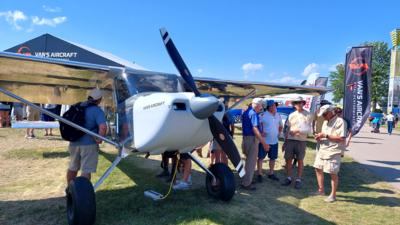
Question: Rob, tell me the overall genesis of this aircraft.
Answer: Van’s has been talking about building a high wing utility airplane for a long time. Long before I hired in, one of my interview questions was, what would you do next? The general market we were going to target with it has been open for debate for a while. What we've decided to do is look at a utility type of airplane. And the general question we're trying to answer is, what do you do when you get to the grass strip. We want you to be able to take enough camping gear to be comfortable to take two full sized bicycles around which fit inside the baggage compartment, to allow you to get there before your buddies and set up by the time they're on the ground.
Q: So it's a two plus two to carry everything get away machine
A: Basically, going in, citing for the airplane has two seats, and we've talked a lot about jump seats and optional third seat, but the design of the airplane is around two people and lots of stuff.

Q: And the Powerplant?
A: 180 To 220 horsepower. The engine we have on the airplane at the show this year is an IO-390 exp 119. Very similar firewall forward package to what we put on our RV-14. We're going to make some changes to that as we go forward and learn a little bit about testing. But it's performing really well as is.
Q: I noticed you had a stabilator instead of a typical horizontal stab and elevator. Was there any specific design reason for that and it being reminiscent of a Helio?
A: Yes, there's a couple of reasons for that. One is we wanted to be able to accommodate a large CG envelope for a large baggage compartment. The other is we wanted a lot of pitch authority to counter any effect of the large flaps, we have with the pitching moment downwash flaps seems to be balancing that out well, but we want to pitch authority to counter it. The third scenario comes from watching a gentleman who shares a hanger with our company president and flying his Maule. It is fairly typical for that category airplanes when they're loaded heavy, and he's controlling his pitch attitude in landing with power fullback stick and he's controlling the pitch of the nose with power, and we don't want to be in that spot.
Q: The rudder is almost reminiscent of the Helio very tall, was that to get e full authority at low speeds?
A: Yes, we're looking ahead to at possibly floats that’s on the horizon after tricycle gear for this airplane. But we wanted right now, was primarily control at low speeds.
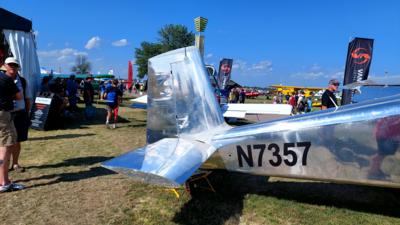
Q: Typical Cessna type float plane kits add a Chrome Moly tubing cross-brace in the windshield area, do you foresee a need for one?
A: It's too early to say we have a lot of design work to do when we get there. We're still talking about options of how we can do floats, we have a strong desire to do our own float kit for this airplane. We have some work to do before we're ready.
Q: The ailerons look like the typical RV, am I pronouncing this correct Fries? Ailerons?
A: Yes, Fries, freeze, I’m not sure how to pronounce either! Yes, the geometry of the ailerons is very similar to the RV-7 that's scaled up in chord of course. The ailerons on this airplane are at 34% chord, most of our other airplanes are 25%. We did that for two reasons, we wanted to maximize the amount of span of flaps that we had to target, the low-speed end of the airplane, and to get the roll authority back we went with a very deep Chord Aileron.
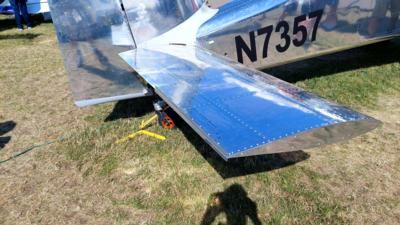
Q: Can you comment at on the airfoil selection?
A: It's a custom airfoil for this airplane. We worked with Steve Smith to design an airfoil for this airplane. Steve designed the airfoil for the RV-10 and the RV-14. We were looking for something that gave us the low drag of the NACA 20312, Low pitching moment with 23012, but a more benign stall characteristic and a high “CL”, and so we decided to tackle the low end of the envelope with wing area and a low drag airfoil rather than a smaller wing and a lot of auxiliary devices, complications and weight, we’d rather stay away from.
Q: In terms of landing gear, its patented applied for, is their animation and or a photos of it out there?
A: We showed them in the forum yesterday. But I don't have any drawings or photos.
Q: And the tail wheel, is it also patented applied for?
A: Yes, the Patent is not granted, but we’ve applied. The landing gear and one of the first things that we did on the airplane so a lot of pencil sketches, napkin sketches, turned into whiteboard sketches and we turned to a really bright young engineer, we have Brian Hickman, who looked at that and said, Yeah, I can do it. We've started at that point built those pieces for a confidence dropped tests before we committed to building an airplane around it. The tail wheel came a little bit later, we laid that out on paper and drove on with it.
Q: It sounds like you had literally did what the automotive world will does, you built a “Mule” loaded it, and slammed it into the ground.
A: Yes, specific drop tests with the landing gear system itself.
Q: And you’ve gone with aviation grade pull type rivet construction?
A: Yes, let me refine that. You’ll find that we have gone with primarily pop rivet construction and the airplane needs the rivet strength as required. So, we use the rivets required for the loads in the location that they require. So, for things like wing skins, we've gotten all pop rivets, we have enough service history field experience with the RV-12 that we're comfortable in the strength of the rivets on this larger category airplane. But there are spots where the loads are higher, and it’s just not enough. So, we have some driven rivets, we have a handful of cherries, as we refine the design, the locations of those rivets are going to change, but on an airplane of this size, there's gonna be some spots where you gotta drive some rivets.
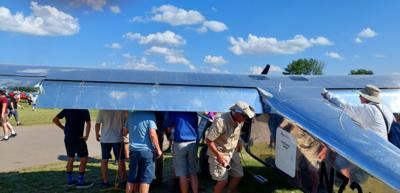
Q: In terms of performance. I think everybody's been curious about the cruise performance given that in this I want to go back off road type of airplane, and you're typically looking at a 100mph airplane, I would imagine the Vans team is shooting for something higher, and that you've probably got a number that you'll give to the public now, but it's not the final number.
A: That's correct. We won't have final numbers published until we get close to the kit configuration. So that's sometime down the road. Our design targets for the airplane are 140 knots true at cruise power 8,000 feet. So that's 75% power with six-by-six wheels and fairings. We have evaluated this configuration as it is not to the ends of the envelope most airframe that we brought here is a test article. So, we're not going to go push the limits of the envelope with it, we're going to learn all of the subjective or soft criteria that we want to dial in from this airplane. But the testing that we've done is tracking as expected or better on all the performance numbers that we have.
Q: Since this is a mule/first prototype, imagine there'll be a clean-up and performance can potentially increase as well.
A: Sure, we don't have fairings on the intersections yet and everything's still hanging out in the Breeze. For the test mission that's not required. We want to be able to get in and look inside of everything. But, we have them designed, and they are in the computer, at some point when we're ready, we'll stick them on the airplane and see what benefit we're going to get.
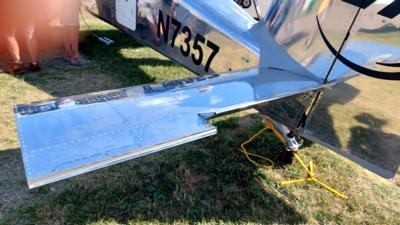
Q: It sounds like you're really testing this one for durability.
A: Absolutely. And mission to the airplane off airport, we routinely fly the rest of our fleet out of a well maintained, but not glass smooth grass strip in Vernonia Oregon, and they hold up reasonably well. But the airplanes are not intended primarily for that type of mission. They're certainly capable of it and they do well with it, but we want an airplane that's going to be able to take you to that strip, and worse, routinely, with no problems.
Q: In terms of entry and egress, was that a design consideration?
A: Absolutely. we talked a lot about ease of access and getting in and out of the airplane. So that informed the size of the door and the configuration of the structure in the fuselage, we wanted to lower forward corner the door as far forward as we can. We have seats on tracks so you can slide back to the back of the door opening, it makes it easy to get your feet in through that tight corner. And then the control stick has a bent shape to it to allow you to slide your inboard foot past the stick without doing any of the gymnastics.
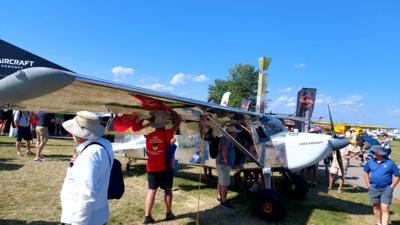
Q: I was I was not able to attend any of the seminars on it, A lot of interest in the big question, 'Are you taking orders?'
A: We're not taking orders yet. We want to make sure that we have the kits ready, and we can deliver on the dates that we promised. We're not here to sell this airplane this year. We're here to show you where we're going and to get you excited for next year. Or estimate is 12 to 18 months for the first sub kit to be available. As we get further into the refining process, we can dial that in and know exactly when it's coming.
Q: This is way out there, and this is a “two plus” airplane, but I would imagine people have already asked for a true full four-seater.
A: Quite a few, it's the same story that you get when you start looking at aircraft configurations, most missions are flown with one or two people even with four seat airplanes. To have a true for place capable airplane like the RV-10 is bigger airplane than we're looking for this mission.
Thank you so much Rob for this interview.
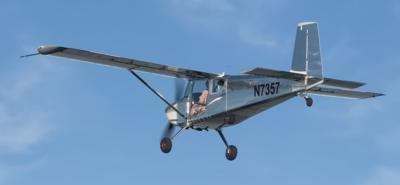
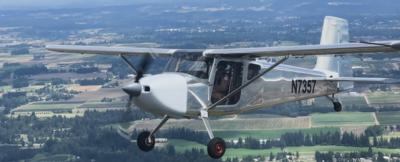

 Airborne 04.16.24: RV Update, Affordable Flying Expo, Diamond Lil
Airborne 04.16.24: RV Update, Affordable Flying Expo, Diamond Lil ANN's Daily Aero-Term (04.20.24): Light Gun
ANN's Daily Aero-Term (04.20.24): Light Gun Aero-News: Quote of the Day (04.20.24)
Aero-News: Quote of the Day (04.20.24) Aero-News: Quote of the Day (04.21.24)
Aero-News: Quote of the Day (04.21.24) ANN's Daily Aero-Term (04.21.24): Aircraft Conflict
ANN's Daily Aero-Term (04.21.24): Aircraft Conflict










